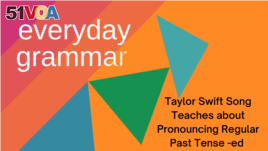09 June 2022
The English alphabet has only 26 letters, but there are over 44 sounds! This can be a problem for English learners.
Today on Everyday Grammar, we will learn about the past tense ending –ed for regular verbs. We will learn that it is pronounced differently depending on the letters it follows.
The suffix –ed is used to form the regular past tense of a verb or as a past participle ending. We use the past tense to talk about things happening before the present or about completed action.

Taylor Swift Song Teaches about Pronouncing Regular Past Tense -ed
For example:
I listened to music this morning at the gym.
I helped my neighbor water her garden.
I waited all day for my brother to call me.
These are all examples of the simple past tense of regular verbs. Did you notice any difference? Listen again to the way that each verb is pronounced.
Listened
Helped
Waited
The –ed ending of all three verbs sounds different. "Listened" has a /d/ sound at the end. "Helped" has a /t/ sound at the end. And "waited" has an /Id/ sound.
Voiced and voiceless sounds
When we speak, air causes the vocal cords to move, producing sound. That sound can be changed using parts of our mouth and tongue to produce words.
If we produce a sound with our vocal cords, we create a vibration that we can feel. Place your hand on your throat while speaking to feel the vibration. These sounds are call voiced sounds. Voiced sounds include all vowels. In addition, the consonants /b/, /g/, /d/, /v/, and /z/ are voiced. So are /m/, /n/, /l/, /r/, /y/, /j/, and voiced /th/ sound, as in the word "the."
For example, the verbs "roam," "believe," and "enjoy" end in voiced sounds.
Voiceless sounds do not use the vocal cords to produce the sound. So, you will not feel a vibration when you say them. Voiceless consonants include /p/, /k/, /t/, /s/, /f/, /sh/ /ch/, and voiceless /th/ like in the word "teeth."
Verbs that have voiceless sounds at the end include "watch," "help," and "laugh."
Three rules
We have three rules in English to help decide how to pronounce –ed endings for regular past tense verbs.
1. If the last letter of the regular verb ends in a voiced consonant or a vowel sound, pronounce the –ed ending as just /d/.
For example:
"Roam" ... "Roamed" (/d/)
"Believe".... "Believed" (/d/)
"Enjoy" ... "Enjoyed" (/d/)
2. If the last letter of the regular verb ends in a voiceless consonant, pronounce the –ed ending as just /t/.
For example:
"Watch" ..."Watched" (/t/)
"Help" ... "Helped" (/t/)
"Laugh" ..."Laughed" (/t/)
3. Finally, if the regular verb ends in either a "t" sound or a "d" sound, pronounce the –ed ending as /Id/ which creates a separate syllable at the end of the verb.
For example:
"Need" ..."Needed" (/Id/)
"Want" ..."Wanted" (/Id/)
"Decide" ..."Decided" (/Id/)
Let us look at these rules in action with an example from a song by Taylor Swift called "Cardigan." Try to hear the different ways Taylor pronounces the verbs with –ed as she sings!
To kiss in cars and downtown bars
Was all we needed
You drew stars around my scars
But now I'm bleedin'
'Cause I knew you
Steppin' on the last train
Marked me like a bloodstain, I
I knew you
Tried to change the ending
Peter losing Wendy, I...
The first past tense verb is "needed." We can hear that "needed" has an /Id/ sound at the end. That is because the verb "need" ends in a /d/ sound.
The next verb is "marked." "Mark" ends in the voiceless consonant /k/. So the voiceless –ed ending /t/ is used.
Lastly, we have "tried." The verb "try" ends in a vowel sound /ai/. All vowels are voiced, so use the voiced sound /d/ as our –ed ending.
Closing thoughts
Today we learned that the pronunciation of the –ed ending for regular verbs in the past tense changes. The correct pronunciation depends on the ending of the root verb. Different pronunciations are used if the root verb ends in a voiced sound, a voiceless consonant, or a /t/ or /d/ sound.
Here is a list of regular verbs. Can you guess how they are pronounced in the past tense?
Mix
Play
Repeat
Cook
Gather
And finally, listen to your favorite songs in English. If the song is in the past tense, can you hear which sounds are used for the regular past tense? Is it a /d/ sound, a /t/ sound, or an /Id/ sound?
You can share your written exercise in the comments below, but also try to say the sounds aloud!
I'm Faith Pirlo.
Faith Pirlo wrote this report for VOA Learning English.
______
Words in This Story
suffix — n. a letter or group of letters added to the end of a word to change its meaning
participle — n. (grammar) a form of a verb that is used to indicate a past or present action and that can also be used like an adjective
vocal cords — n. pieces of tissue in the throat that permit speech
pronounce — v. to make the sound of (a word or letter) with your voice
vibration — n. the act of shaking with small, quick movements
roam — v. to go to different places without having a particular purpose or plan
syllable — n. a part a word is naturally divided into when pronounced.
cardigan — n. a sweater with buttons
bars — n. places where alcohol is served
scar — n. a mark that is left on your skin after a wound heals
bloodstain — n. a spot marked with blood












